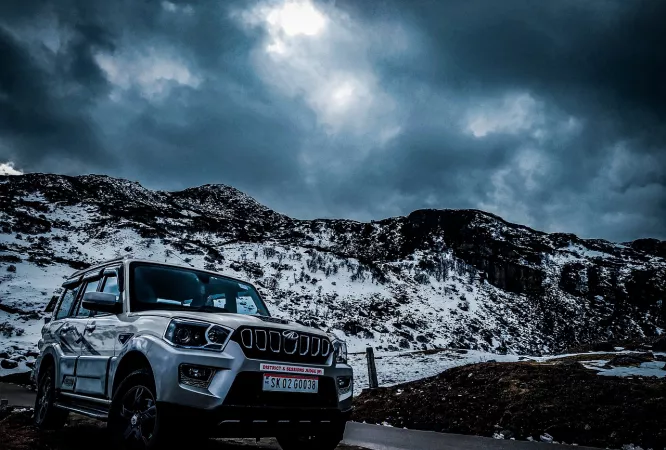Gyalshing Travel Guide
Gyalshing, also known as Geyzing, is a picturesque town located in the West Sikkim district of Sikkim, India. Situated at an altitude of 6,500 feet, Gyalshing is surrounded by the majestic Himalayas and lush greenery. The town holds historical significance as it was once the capital of the former kingdom of Sikkim. Gyalshing is renowned for its rich cultural heritage, vibrant festivals, and stunning natural beauty, making it a popular destination for travelers seeking a tranquil retreat in the mountains.Top Attractions in Gyalshing
- Pemayangtse Monastery
- Rabdentse Ruins
- Khecheopalri Lake
- Sanga Choeling Monastery
- Changey Waterfall
Gyalshing is Famous for
The town of Gyalshing is most famous for its ancient monasteries, breathtaking mountain views, and serene lakes.Top Attractions in Gyalshing
- Explore the mystical Pemayangtse Monastery
- Discover the ancient ruins of Rabdentse
- Experience the tranquility of Khecheopalri Lake
- Visit the historic Sanga Choeling Monastery
- Admire the beauty of Changey Waterfall
What's Great about Travelling to Gyalshing?
- Perfect destination for nature lovers
- Offers a peaceful and spiritual retreat
- Opportunity to immerse in local Sikkimese culture
What's Not So Great about Travelling to Gyalshing?
- Limited accommodation options
- Remote location may not be suitable for all travelers
- Challenges with transportation infrastructure
Travel Tips for Gyalshing
- Ensure to carry warm clothing due to the mountain climate
- Respect local customs and traditions while visiting monasteries
- Book accommodation in advance, especially during peak tourist seasons
Important Gyalshing trip information
- Ideal Duration: 2-3 days to explore the main attractions
- Best Time to Visit: March to May and October to December for pleasant weather
- Nearby Airports and Railway Stations: The nearest airport is Bagdogra Airport, and the closest railway station is New Jalpaiguri Railway Station.
FAQ's on Gyalshing
Q1: What is the best time to visit Gyalshing?
The best time to visit Gyalshing is during the months of October to March when the weather is pleasant and ideal for exploring the beautiful landscapes and monasteries. This period also coincides with various festivals and cultural events, offering a rich cultural experience for tourists. However, if you are interested in trekking and outdoor activities, the months of April to June provide clear skies and favorable weather for adventure enthusiasts.
Q2: Do I need a visa to travel to Gyalshing?
vary depending on your nationality. Most visitors will need a valid visa to enter the country. It is recommended to check with the nearest embassy or consulate for specific visa requirements. Certain nationalities may be eligible for visa on arrival or e-visa facilities. Make sure to have a valid passport with at least six months validity beyond your intended stay.
Q3: What are the must-visit attractions in Gyalshing?
Gyalshing boasts a range of must-visit attractions, including the Pemayangtse Monastery, Khecheopalri Lake, Rabdentse Ruins, Tashiding Monastery, and the Singshore Bridge. Visitors can also explore the stunning Kanchenjunga National Park, home to diverse flora and fauna, and enjoy panoramic views of the Himalayas from various viewpoints around the town.
Q4: Is Gyalshing a safe place to travel?
Gyalshing is generally a safe destination for travelers. However, it is advisable to be cautious of your belongings and avoid isolated areas, especially at night. It is recommended to follow local customs and respect the culture of the region. Travelers are advised to stay informed about the current situation and adhere to any travel advisories in place.
Q5: What is the local currency in Gyalshing and can I use credit cards?
The local currency in Gyalshing is the Indian Rupee (INR). While credit cards are accepted in some hotels and larger establishments, it is advisable to carry cash for smaller purchases and in remote areas. ATMs are available in major towns, but it is recommended to carry sufficient cash when traveling to more rural locations.
Q6: What is the local cuisine like in Gyalshing?
offers a variety of local delicacies, including momos (dumplings), thukpa (noodle soup), phagshapa (pork dish), and gundruk (fermented leafy greens). Vegetarian options like chhurpi soup and kinema are also popular. Visitors can savor the unique flavors of Sikkimese cuisine influenced by Tibetan and Nepalese culinary traditions.
Q7: What transportation options are available in Gyalshing?
Transportation options in Gyalshing include public buses, shared taxis, and private car rentals. Visitors can also hire a local guide for sightseeing tours or opt for organized tours operated by travel agencies. It is advisable to book transportation in advance, especially during peak tourist seasons, to ensure smooth travel arrangements.
Q8: Are there any cultural norms or etiquette I should be aware of when visiting Gyalshing?
When visiting Gyalshing, it is important to respect the local customs and traditions. Dress modestly, especially when visiting religious sites, and remove your shoes before entering monasteries or homes. Greetings are usually with a slight bow and a "Namaste." Avoid public displays of affection, and always ask for permission before taking photographs, particularly of locals. Embracing the local culture with an open mind will enhance your travel experience in Gyalshing.
Q9: I am a travel agent. How can I buy travel leads of Gyalshing?
Register yourself as a travel agent at agents.tripclap.com and then you can buy travel leads to Gyalshing once your account is approved. For more details contact our support team at +91-8069186564 or support@tripclap.com

